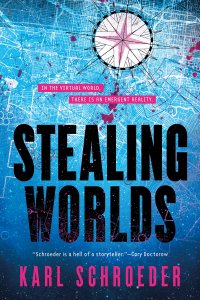Paul Di Filippo reviews Past Futures
The Good Neighbor Policy was a famous reformulation, during the 1930s and 1940s, of the military-political relationship among the USA and its Latin-American allies and neutrals. Basically, it affirmed a stance of no interference by the USA, along with mutual cooperation and assistance towards common goals. This bit of potentially arcane federal diplomacy became so well known that reference to it cropped up in many Hollywood movies of the time, in which Mexico and parts south were represented as exotic, laid-back realms of fun and frolic and sometimes intrigue. Carmen Miranda, we salute you! Perhaps the most famous instance of Hollywood’s fascination with the region manifested with two cartoons from Disney: Saludos Amigos and The Three Caballeros, in which Donald Duck got to chill with his Latino counterparts, Jose Carioca and Panchito Pistoles.
This era certainly represented the apex of US pop culture involvement with Latin America, although the Bossa Nova craze of the Fifties and Sixties represented another brief flare-up, through which the Girl from Ipanema sauntered. One curious codicil to all this, involving science fiction writers and leading into discussion of our current book, was the Third Annual International Film Festival held in Rio de Janeiro during March of 1969, to which were invited several Anglophone SF writers, including Brian Aldiss, J. G. Ballard, John Brunner, Philip Jose Farmer, Robert Heinlein, Arthur C. Clarke, Frederik Pohl, Robert Sheckley, and Harry Harrison. Such North-South détente, inside SF or outside, would be sparse in subsequent years.
But of course, cultural activity in the region did not freeze or cease every time we in the upper hemisphere turned our attention elsewhere. And in 1957, with the launch of Sputnik and the dawn of the Space Age, artists in Latin America cast their eyes to the heavens just as their North American counterparts did, and began to incorporate Space Age imagery into their works.
Past Futures is the physical record of an exhibition mounted at Bowdoin College which sought to reveal this hidden 1960s realm of SF-inspired painting, sculpture and installations. As such, its focus is on “fine art,” not pop culture iconography per se. For such a catalogue, you could consult a volume like Gregory Benford’s Popular Mechanics The Wonderful Future that Never Was: Flying Cars, Mail Delivery by Parachute, and Other Predictions from the Past.
Let’s take a look at the essays first. Editor Sarah Montross opens up the proceedings with a fine overview of the history, “Cosmic Orbits: Observing Postwar Art of the Americas from Outer Space,” which gives us the various trends and schools and politics of the era, and gets us familiar with the names and reputations and stances of the selected artists. She makes a good case that Latin American space art existed in an “alternative dimension” from its northern neighbors, due to a Gibsonian “uneven distribution of technology.” Next up is Miguel Ángel Fernández Delgado with “Saudade for Space, Utopia, and the Machine in Latin American Art.” He really digs into the way written SF influenced these creators, and how the overall attitude of the artists was more utopian than otherwise. “Argentines on the Moon,” by Rodrigo Alonso, transports the giddy reader back to a Swinging Sixties esthetic predominant in Argentina, a realm of joyous colors and playful performances. Finally, Rory O’Dea hones in on the work of one man, a figure unknown to me prior to this. “Reflections on Science Fiction: The Other Side of Robert Smithson’s Mirror-Travel” talks about Smithson’s resonance with Ballard and other New Wave authors, and how Smithson turned modern debris-filled landscapes into otherworldly venues.
The art that accompanies these essays, lushly reproduced on rich stock, is astonishing in its range and novelty to viewers dominated by Northern creators. We find the Chilean, Matta, whose work might conjure up comparisons to Richard Powers or Gene Szafran. Many of his paintings here would still make excellent non-representational covers for SF books. Then there is the Mexican Dr. Atl, who does realistic stuff on the lines of Chesley Bonestell. On the other hand, Argentinean Xul Solar has a kind of cartoony style, while his compatriots, the team of Delia Cancela and Pablo Mesejean, bring to mind the heady psychedelics of Ron Walotsky. And in a painting like Enrique Careaga’s “Sphere Spatio-Temporelle BS 7523,” one sees a sly nod to cinematic imagery: to me, those three slitted spheres evoke nothing so much as the cyclops head of the robot Gort, from The Day the Earth Stood Still.
As O’Dea observes, “science fiction is intimately connected to modernism, and both share a conceptual logic…” But that linkage manifests itself in many ways depending on national sensibilities. One finishes this book eager for further glimpses of this mirror world, where the Space Age was filtered through eyes and brains molded by other traditions. Matching up this volume with Rachel Haywood Ferreira’s The Emergence of Latin American Science Fiction and with Cosmos Latinos: An Anthology of Science Fiction from Latin America and Spain by Andrea L. Bell and Yolanda Molina-Gavilán would open up a stimulating window on a much-neglected part of SF’s global heritage.








